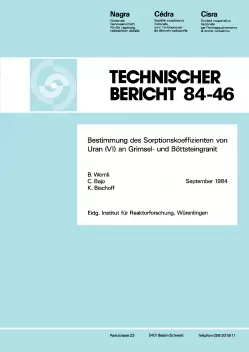
Technischer Bericht NTB 84-46
Bestimmung des Sorptionskoeffizienten von Uran (VI) an Grimsel- und Böttsteingranit
A batch method has been used on powdered granites and the sorption coefficients (Rd) of uranium(VI) found are presented.
Rock material from the Grimsel and from drill cores at Böttstein were used. After quarrying and milling the granitic material, the specimens were gained by splitting the granitic powders; in this manner every sample was representative of the unbroken rock material.
The particle size distribution of the different rock materials was obtained by dry sieving the rock powders. A specific surface area between 260 and 330 cm2/g for the different powders was found by using a standardized calculation model.
The sorption coefficient was obtained by six different experimental series at room temperature and normal atmospheric conditions. The powdered rock samples were held in contact with the uranium containing solution (three types of water used, uranium levels from 2 to 2000 ng/ml) for periods between 3 and 17 weeks. The experiments with a uranium concentration of 2 ng/ml were done with double distilled water. Other experiments were carried out using a slightly mineralized water: This was produced by allowing equilibrium to occur between distilled water and granitic powder and subsequent filtration. A third water type was the highly mineralized water from Säckingen. The increase of the rock/water ratio from 1/20 to 1/2 gave not only higher Rd values but also favoured a considerable leaching of the uranium content of the granites. Correspondingly in further experiments uranium-233 was used as a tracer. The results of these experiments showed a leaching of the uranium of up to 6 % of the total granitic uranium content; the added uranium concentration was therefore considerably increased.
As a result of the tracer experiments, Rd values between 3 and 30 ml/g and 3 and 15 ml/g respectively for Grimsel and Böttstein granite were found.
For the granites studied leaching differences were found, but could not be related to the degree of alteration of the rock materials.
The measured Rd values are in good agreement with the values published in literature. Only slight differences in the sorption behavior of the granites could be established in spite of different origin and different degree of weathering. For the sorption behavior of uranium(VI) on granite a Rd value of at least 5 ml/g is desirable.
